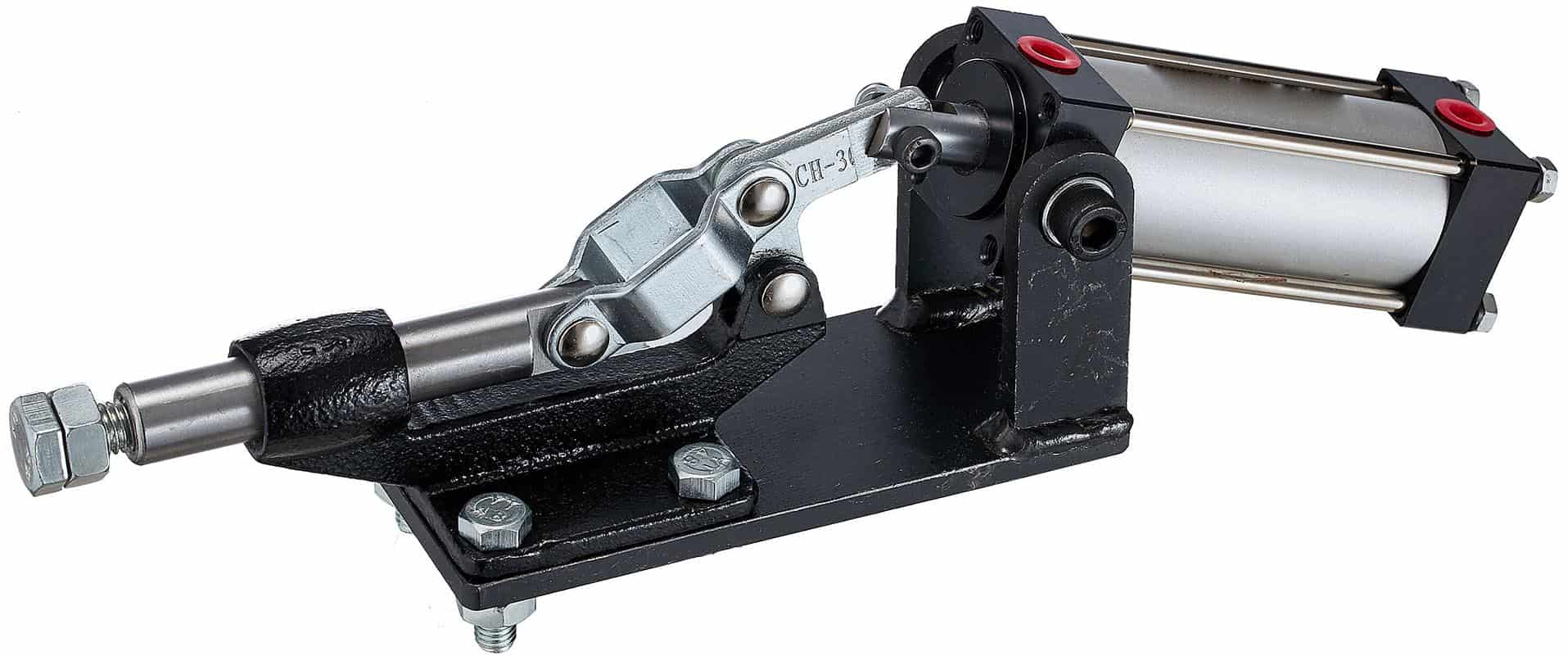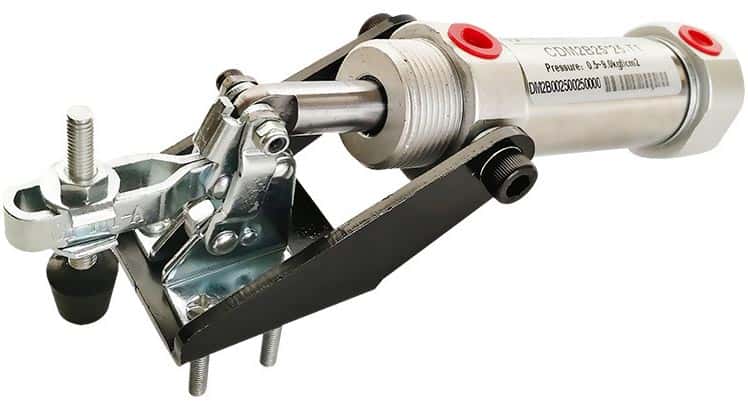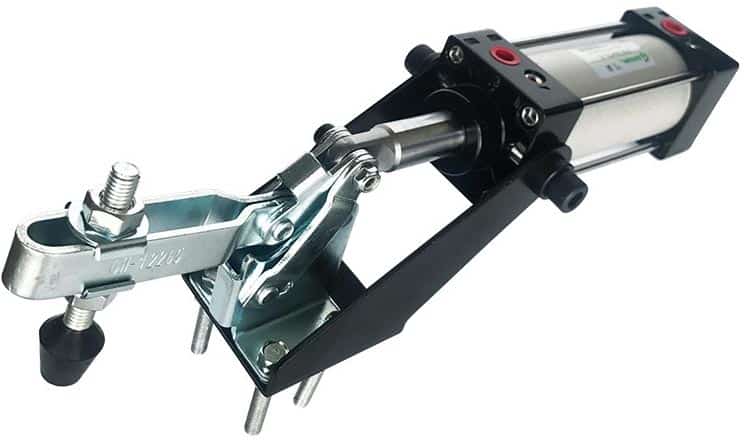Heavy-duty pneumatic toggle clamps are powerful and versatile clamping mechanisms that are widely used in a variety of applications. These clamps are designed to provide a high level of clamping force with minimal effort, making them an ideal solution for applications that require a secure and precise hold. In this guide, we’ll explore the workings of these clamps, their benefits, materials, applications, installation and use, maintenance requirements, and cost-effectiveness.
How do heavy-duty pneumatic toggle clamps work?
Heavy-duty pneumatic toggle clamps work by using compressed air to generate the clamping force. The clamp consists of a cylinder, a piston, and a clamping arm. When air is introduced into the cylinder, it pushes the piston and the clamping arm toward the workpiece. This generates a clamping force that holds the workpiece securely in place.
One of the advantages of pneumatic toggle clamps is that they can be easily automated using a solenoid valve, which allows them to be integrated into larger automated systems. They can also be customized with different arm lengths and shapes to suit specific applications. Based on this advantage, it has to have higher efficiency and reliability than the traditional heavy-duty toggle clamps.

What are the benefits of using toggle clamps?
Heavy-duty pneumatic toggle clamps offer a number of benefits over other types of clamps. They provide a high level of clamping force with minimal effort, which can reduce operator fatigue and improve productivity. They are also highly reliable and durable and can be used in a wide range of applications, from automotive assembly to woodworking. Pneumatic clamps for woodworking are very widely used in the woodworking field and are used in large quantities.MAILONG specializes in customizing different sizes of toggle clamps for this field.
In addition, pneumatic toggle clamps are easy to use and can be controlled with a simple foot pedal or a hand lever. They can be customized with different arm lengths and shapes to accommodate a variety of workpieces. And can be easily automated for use in large-scale production environments.
What materials are pneumatic toggle clamps made of?
Heavy-duty pneumatic toggle clamps are typically made of durable and high-strength materials such as steel or stainless steel. Steel is a popular choice for these clamps because of its high strength and durability, while stainless steel is often used in applications where resistance to corrosion is important.
The clamping arm and other components of the clamp are typically machined to tight tolerances, ensuring a precise fit and smooth operation. In addition, some manufacturers use specialized coatings or treatments to enhance the performance and durability of their clamps.

What are the most common applications for pneumatic toggle clamps?
Heavy-duty pneumatic toggle clamps are used in a wide range of applications, from manufacturing and production to woodworking and metalworking. They are often used to hold workpieces securely in place during cutting, drilling, welding, or other operations.
In manufacturing and production, pneumatic toggle clamps may be used to hold components in place during assembly or to secure workpieces in jigs and fixtures. In woodworking. They may be used to hold pieces of wood together while the glue dries, or to secure a workpiece to a jig. In metalworking, they may be used to hold a piece of metal in place while it is being cut or shaped.
How do you install and use pneumatic toggle clamps?
Installing and using heavy-duty pneumatic toggle clamps is relatively straightforward. To install the clamp, it is typically attached to the work surface using screws or bolts. The clamping arm is then positioned over the workpiece, and the clamp is activated using a foot pedal or a hand lever. The locking mechanism is engaged to keep the clamp in place, and the workpiece is securely held in place.
When using a heavy-duty pneumatic toggle clamp. It is important to ensure that the clamp is properly aligned with the workpiece and that the workpiece is securely held in place. It is also important to select a clamp that is appropriate for the size and shape of the workpiece. And to use the proper air pressure to achieve the desired level of clamping force.

What are the maintenance requirements for pneumatic toggle clamps?
To ensure optimal performance and longevity of pneumatic toggle clamps, it is important to maintain them regularly. This may involve cleaning the clamp after use, and inspecting it for signs of wear or damage. And lubricating any moving parts to ensure smooth operation.
It is also important to ensure that the air supply to the clamp is clean and dry. As moisture or debris in the air can cause damage to the clamp over time. In some cases, it may be necessary to replace worn or damaged components to maintain the performance of the clamp.
How do pneumatic toggle clamps compare to other types of clamps in terms of performance and cost?
Heavy-duty pneumatic toggle clamps offer a number of advantages over other types of clamps. They provide a high level of clamping force with minimal effort, which can reduce operator fatigue and improve productivity. They are also highly reliable and durable and can be used in a wide range of applications.
In terms of cost, pneumatic toggle clamps may be more expensive than some other types of clamps. Such as manual toggle clamps or screw clamps. However, their superior performance and durability may make them a more cost-effective choice in the long run. Especially in high-volume production environments.
Based on my personal experience, pneumatic toggle clamps are versatile and reliable clamping solutions that offer a number of benefits over other types of clamps. They are easy to use, highly customizable. And can be automated for use in large-scale production environments. By understanding the workings of these clamps, their materials, applications, installation and use, maintenance requirements, and cost-effectiveness, you can select the right clamp for your specific needs and achieve optimal performance and productivity.
